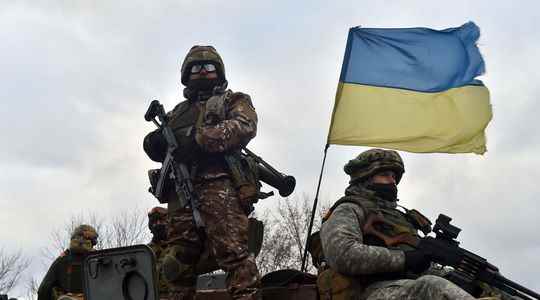Will go, won’t go? The implacable Russian leader Vladimir Putin, who has massed his army at the gates of Ukraine, continues to mount the pressure for an invasion of the country. Diplomatic options for avoiding armed conflict are shrinking day by day. Russia and the United States – which came to the aid of Ukraine in this case – have made an appointment “next week” for new talks after the session held on Friday. Russian demands are particularly demanding, like the withdrawal of NATO foreign troops from Romania and Bulgaria.
What will happen if the threat materializes in Ukraine? According to the latest version of Global Firepower Index (GFP), by 2022, Ukraine would be the 22nd most militarily equipped nation in the world. Russia, which had already taken possession of the Crimean peninsula in 2014, occupies the 2nd position, sandwiched between the United States (1st) and China (3rd). A world separates the two countries on this point. But a little less than imagined all the same.
Indeed, Ukraine’s military capacity has drastically improved in less than ten years. “In 2014 [au moment de l’invasion de la Crimée par la Russie] Ukraine’s defense minister said the country had 6,000 combat-ready troops. Today, the Ukrainian army has about 145,000 to 150,000 soldiers and has significantly improved its capabilities, personnel and readiness,” noted a summary from the US Congressional Research Service carried out in June 2021. The Global Fire Power today evokes an estimate of 200,000 men ready to do battle.
The expert in international conflicts, teacher at Sciences Po, Julien Théron, adds in an article published on the site The Conversation the new appearance of “territorial defense battalions”, established by the national resistance law, which came into force on 1 January. “In these units of civilians trained by the army, citizens learn how to conduct guerrilla tactics with their own weapons against foreign forces. These battalions pose a serious challenge to any occupation,” he explains.
However, the account remains very far from the 800,000 men who can be mobilized on the Russian side, with in addition a military budget more than ten times higher.
A hasty defense
Worse, the Ukrainian army, certainly more numerous than before, is also struggling on the material dimension: planes, tanks, weapons, missiles. “Despite a large defense industry and arms stockpiles, much of Ukraine’s equipment is obsolete or in need of major repairs,” the US Congress also said in its note. “Part of Ukraine’s defense industry capacity was lost in 2014-2015, as more than 20 defense industry enterprises, including ammunition factories, were based in parts of Ukraine”, complete Atlantic Council think tank.
Ukraine – which in 2020 allocates 4% of its GDP to its military expenditure – is therefore trying to modernize its equipment at high speed, relying on its Western support. Since 2014, NATO, as an organization, and certain member countries “have provided considerable assistance, which is equivalent to approximately 14 billion dollars”, estimates Nicolo Fasola, specialist in space security issues. former Soviet Union at the University of Birmingham, with France 24. Most recently, in November, Washington delivered about 88 tons of munitions, including nearly three dozen javelin throwers and 180 missiles, to Kiev. Earlier this week, Britain also said it had started supplying anti-tank weapons to Ukraine.
This Friday, Estonia, Latvia and Lithuania announced that they would in turn send anti-tank and anti-aircraft missiles to Ukraine to enable it to defend itself “in the event of a possible Russian aggression”. The three Baltic countries said in a statement that they would send American Javelin and Stinger missiles after receiving authorization from Washington earlier this week.
Kyiv on its own finally bought 12 Bayraktar drones from Turkey. On the human level, Ukraine receives help via the support of American, British and Canadian military instructors, informs Le Figaro.
“Considerable” costs
Some Western democracies, Germany and the United Kingdom in the lead, have thus warned Russia of the possible “quagmire” in which it would get entangled, “as during Soviet Afghanistan and the conflict in Chechnya”. “It must be clear that in such a situation, Russia must expect considerable and serious costs,” commented the German chancellery in particular on Friday.
“A full-scale Russian invasion of unoccupied Ukraine would be by far the largest, boldest and riskiest military operation Moscow has launched since the 1979 invasion of Afghanistan,” the Institute insists. War Studies (ISW), a US-based think tank, in a report. It would cost Russia huge sums of money and probably several thousand casualties and destroyed vehicles and planes. Even in victory, such an invasion would impose on Russian President Vladimir Putin the obligation to rebuild Ukraine and then establish a new government and security forces there more suited to his purposes.
The warning is issued. Is it necessary to specify, lastly, that the last of the defenses resides in the capacity of resistance of the people in itself. On this point, Russia may also be worried. “According to a poll by the Kiev International Institute of Sociology published in December, 58% of Ukrainian men and almost 13% of Ukrainian women say they are ready to take up arms to defend the country against a Russian invasion, and respectively 17% and 25% more say they are ready to resist in other ways,” reports Julien Théron.
This data may have motivated the recent cyberattacks against government sites, or even the bogus bomb threats, seen in Ukraine. Symbolic actions aimed at deceiving, or quite simply undermining the morale of the population, and about which Moscow is the main suspect.
